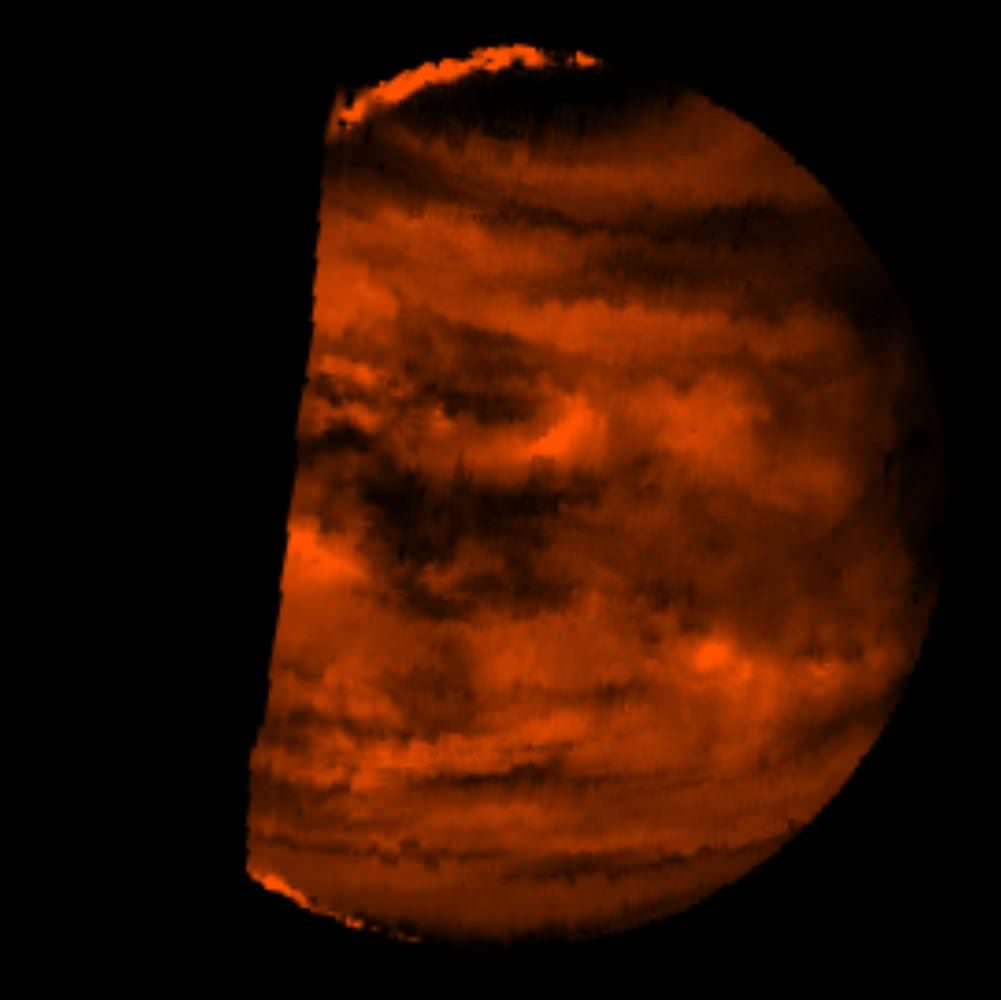Here’s a new image for the Where In The Universe Challenge, to test your visual knowledge of the cosmos. You know what to do: take a look at this image and see if you can determine where in the universe this image is from; give yourself extra points if you can name the spacecraft/telescope responsible for the image. We’ll provide the image today, but won’t reveal the answer until later. This gives you a chance to mull over the image and provide your answer/guess in the comment section. Please, no links or extensive explanations of what you think this is — give everyone the chance to guess.
The answer for the previous WITU challenge can be found here.
UPDATE: The answer has been posted below.
This is a a near-infrared image of lower-level clouds on the night side of Venus, taken by the Galileo spacecraft’s Near Infrared Mapping Spectrometer, taken as the spacecraft flew by Venus on February 10, 1990, as it was wending its way towards Jupiter. You can learn more about his image at JPL’s Photojournal.


Venus.
My first thought was that it was the Neptune Infrared that was taken a few days back, but I don’t think it’s that, so I’m going to go with an Infrared pic of Venus.
Venus
Venus as seen from Galileo probe.
titan rise behind saturn, by galileo?
I have to chime in with most others: When I looked at the photo for a few moments, my first thought was an infrared image of Venus.
Neptune. Voyager 2.
Neptune, Voyager 2.
Venus from Galileo
Venus in infrared from Galileo spacecraft taken in July 2006
False color image of Venus’ clouds as imaged by the NIMS instrument on Galileo.
http://nssdc.gsfc.nasa.gov/photo_gallery/photogallery-venus.html
P.S : i did Google Image Search 🙂
Cheater, cheater broke the rules, nah nah, Just funnin:-)
Wait – Galileo did a gravity-assist around Venus to get to Jupiter? How does that work? That seems counterintuitive…
Look up the mission path, made better sense to me after I saw a diagram 🙂
That is Nibiru The Brown Dwarf Star Our Sun’s Companion Dark Twin, It has seven orbiting Planets and is what the New Film Melancholia is about. It Was discovered in 1983 by Iras the infrared astronomical satellite. There are more articles about it in Science Magazines that date back to 1961 I think 1972 also and many more years up to 1984. Governments have known since the 1920’s or 1930’s.
So it was discovered in 1983 but articles have been written about it since 1961? What is it, a tachyon star?
Brown Dwarf Star
Right. Except the bright infrared sources that were found by IRAS in 1983 turned out not to be nearby brown dwarves, but distant gas clouds in our galaxy or very distant members of a new class of object known as Ultra-luminous Infrared Galaxies (ULIRGs):
http://www.badastronomy.com/bad/misc/planetx/science.html
In other words, not Nibiru. A stellar companion to our sun has been hypothesized and speculated about, but it has never actually been found. Until then, Nibiru is fiction, not fact.
Pretty sure that’s Venus taken from the Galileo spacecraft as it did a fly-by.
It IS the …multi-millenia old Chinese legend …alive.
David Morrison NASA Space Scientist – Explains this and more . . .
Venus for sure,and IR also, however I had no idea as to the platform/satelite that took the photo! Dredging up a 20year+ photo is just a bit sneaky in my opinion.
What. This is not Comet Elenin (oops, I mean brown dwarf Elenin) just as it passed behind the Moon (before it reportedly broke up)?
I’m just devastated. Devastated!
/sarc/